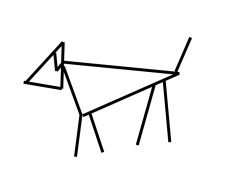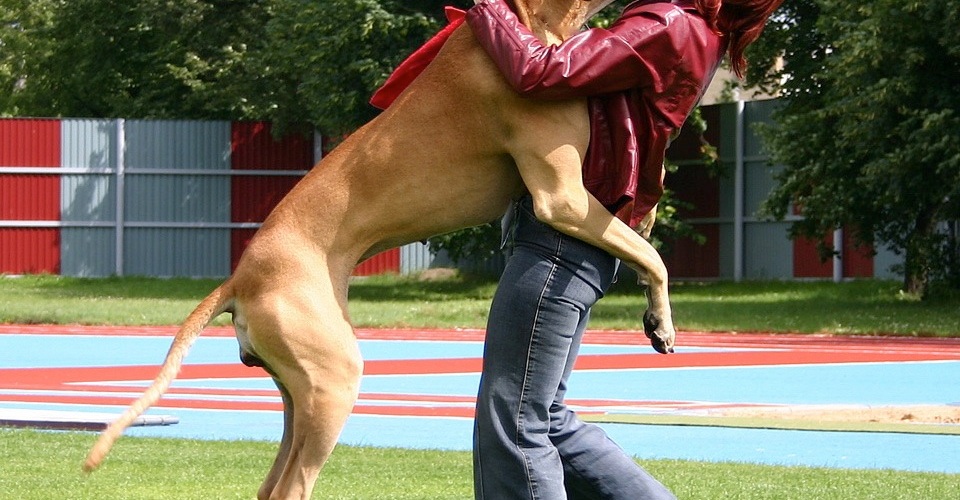I’ve never really been a small dog person, and when I decided I would get a big dog, I immediately knew that I wanted it to be well trained. I think it’s particularly important for bigger dogs to have exceptional manners, since they have a lot more weight to throw around. That being said, dogs of every size, breed and age should at the very least learn basic obedience. Why? It’s a courtesy to the general public, as well as making being a dog owner all the more pleasurable and keeping your dog mentally and physically active.
How you ended up being that dog owner
Training isn’t just for “bad” dogs, but many people find themselves turning to training only when things have gotten unbearable. When you’ve got a puppy, it can be easy to let bad behaviour go unchecked. Of course it’s cute when a 6 week old puppy jumps up to lick you on the chin, but 12 months later when it weighs 40kg? Not so cute. Behaviours like jumping up, whining, barking, pulling on the lead and aggression towards other people and dogs are not ideal and certainly won’t win you any friends when out and about. Training for just 5 minutes a day is all that it takes to eradicate these nasty habits.
Most of these behaviours, your dog has learned from you! By shushing a bark, you give the dog attention (what it wanted in the first place). By allowing your dog to get to a tree when it pulls towards it with all it’s weight, you teach it that pulling=getting where they want to go. When greeting others, if your dog jumps up and immediately gets pats and lots of attention, it knows exactly how to get it next time. The first thing you need to do if your dog is like this, is realise what you are doing to reinforce (reward) it. Make a list; the behaviour you (or others) don’t like, the disadvantages of the behaviour and the reward the dog gets for doing it. When you understand how much you’ve unknowingly trained your dog into bad behaviours, take comfort in the fact that your dog responds well to training! Now you just need to start training positive behaviours.
The Basics
When I say I wanted my dog to be “well trained”, I had an idea in my head of what that meant; I find this is a very different idea depending on who you talk to. For some people, coming when called (aka ‘recall’) is well trained. Sitting when asked is well trained. The absence of behaviours like barking is well trained. For others, these things and much, much more go into a well trained dog. It really depends what you want from your dog, and what suits it too.
At the very least, all dogs should know basic obedience (“know” meaning responding correctly 90% of the time). For me, that’s basic commands like:
- come
- sit/drop
- stay
- heel
With these commands alone, you can manage to stop your dog running onto a road if you drop the leash, call your dog away from danger, walk calmly on the lead and most importantly, say “please”. For me, this is the most important part of basic training. With a sit/drop command, you give your dog a tool; manners. What does good manners get you? Pretty much anything. For instance, Atlas needs to use his “please”s to get his meals and treats, go off lead and get his ball thrown. He very clearly understands that by responding to commands, he gets what he wants. It’s a win-win.
Important Training Tools
There aren’t many people who work for free, so why would your dog? I don’t ask Atlas to do anything unless I am giving him something in return. Because he is a lardy, food is the most obvious, and often the best, treat. Roast chicken, hot dogs, liver, chicken heart and pet food logs, all fried up, can get him to do pretty much anything. These are “high value” food treats – I reserve these for training new and/or challenging commands and training in very distracting environments (e.g. dog park full of dogs). If I’m asking Atlas to do something simple in the quiet of home, a regular biscuit will suffice. Find out what your dog likes – try lots of different (especially smelly) things to see what works best.
Apart from food, there are many other things your dog enjoys. Some dogs are toy crazy, so use play as a reward (like police dogs!). Other dogs will do anything just to get attention, so use lavish praise as a reward. If your dog likes getting in the car, on the couch, outside, inside or off leash, use the action as a reward – just make them say “please!” first.
The idea of getting a reward for doing the right thing is called positive reinforcement, and forms part of a teaching method called operant conditioning. This method of teaching goes like this; the individual performs an action and receives a response. In general terms, the response either makes them want to do it more (reinforcement) or less (punishment). Both responses can be either positive or negative, with the same effect (NOTE – “positive” and “negative” do not mean “good” and “bad” here). I’ll explain with examples below to make things clearer.
POSITIVE REINFORCEMENT
giving a reward for the correct response
(e.g. giving a food treat for sitting when asked)
NEGATIVE REINFORCEMENT
removing something unpleasant for the correct response
(e.g. releasing pressure on the leash when the dog is at heel)
POSITIVE PUNISHMENT
use of something unpleasant for incorrect response
(e.g. pulling hard on the leash if a dog will not heel)
NEGATIVE PUNISHMENT
removing a reward for the incorrect response
(e.g. not giving a food treat if dog drops when asked to sit)
It’s incredibly important to understand the difference between these responses and to use them appropriately. In our training I use positive and negative reinforcement and negative punishment, but avoid using positive punishment, as I find it unnecessary and also generally not nice.
Don’t go it alone!
It can be easy to get frustrated and give up after one session, so it can be best to start off with help. There are a plethora of online training resources (including photo and video tutorials) and “how to” books, but I find nothing compares to some real life assistance. There’s also plenty of this kind of help available, so much so that the options can become a bit overwhelming. To be brief, ‘professional’ training is available from one of three groups; accredited dog trainers, kennel clubs and third parties such as vets and pet supply stores.
If you have a dog which you think needs one on one attention, or has serious behavioural issues, private sessions with a dog trainer are your best bet. If you just want to learn some basic (or even more advanced) commands and have fun with other dogs and dog owners, a kennel club is your best bet. They are scattered all over Sydney and are generally a low cost operation, run by volunteers, who are usually accredited trainers, working on their day off! This is how Atlas learned most of what he knows, thanks to the lovely team at Leichhardt Dog Training Club, who charge just $15 for a year pass to classes, which run every Sunday. This gives us the flexibility to come when we can, which is usually once a month.
Third party training, run through dog related companies, are something I myself would never go for. Firstly they tend to be extremely expensive; $100+ for 4-6 week courses. Secondly, not all are run by actual dog trainers. While training can be relatively simple, it’s good to have an expert for any tricky canines. Lastly, I enjoy the flexibility of a kennel club (or a private trainer) over the stock standard program of a “puppy pre-school” type set up.
Whatever help you choose, it will fast track you on the road to success! We hope you find something that works for you and your pup as well as it has worked for us.
With love,







2 thoughts on “Dog Training for Beginners”